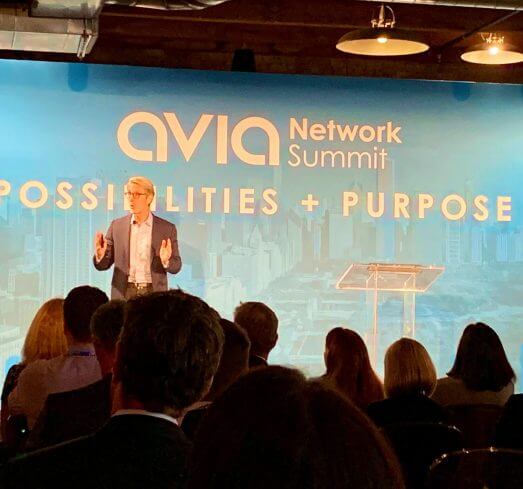
AVIA’s Guide to Scaling Healthcare Innovation
AVIA
Insights
AVIA

“Quietly, AVIA has become the biggest market force in healthcare.” — Former CMS Administrator Andy Slavitt
The most memorable quote from the 2019 AVIA Network Summit came toward the end of the second day, in a packed general session room of more than 250 health system leaders, solution company and industry partner executives, and AVIA employees. The statement turned heads and raised eyebrows — it was bold, declarative. More than that, it spoke to the depth and reach of impact that AVIA Members are creating in the industry.
Acting with speed and intention, AVIA’s 45+ Members are pushing the boundaries of digital and integrating it throughout their organizations to transform healthcare. Every aspect of the 2019 Summit put that notion prominently on display. Every presentation, conversation, and peer-to-peer connection underscored the urgency for action and the scale of change undertaken.
Later this summer, AVIA will release a more comprehensive report of insights and learnings from the Summit. For now, we’ve captured some of the most notable comments presented at the Summit, grouped across three prominent themes woven through the entire event:

AVIA Members have progressed well beyond the time of tinkering with digital. The sea change has occurred, and today, dozens of Members have put digital at the core of initiatives that seek to answer the previously unanswerable questions related to cost sustainability, patient access, consumerism, clinical capacity, and a host of other vexing challenges. They’ve put themselves in the disruptor’s seat to create the degree of change that’s needed to serve their communities more effectively.
“Being disruptive is the only way to survive. To succeed in risk with Medicaid, systems need to lean in quickly. Otherwise they will never get to health equity. We’re investing in value in the community — not just housing and transportation but things like community health workers and a coordinated care network that started through our work with AVIA. We’re all in on investing in value because we know we have to be.” — Bettina Tweardy Riveros, Chief Health Equity Officer, Christiana Care Health System
Patrick Conway, CEO of Blue Cross and Blue Shield of North Carolina, described how his organization is moving beyond incremental change and striving to improve health at a population level. To do so, BCBSNC will invest in both primary care and also moonshots across North Carolina — with the goal of moving North Carolina from the 37th healthiest state in the U.S. to first, all within a generation.
“We need to use every possible tool in our tool chest. Don’t just do one thing by yourself. Get the best people, find peers and partners, invest in community solutions, bring ideas to policy leaders. That’s what it takes to generate change” — Andy Slavitt
“Healthcare costs are going up faster than revenues … so we need to accelerate change. That means working to eliminate value defects in healthcare — by organizing around primary care, anchoring around patient needs, and engaging every employee (both clinical and non-clinical) on the value journey.” — Peter Pronovost, Chief Clinical Transformation Officer, University Hospitals

Digital and innovation leaders at health systems have always been agile change agents for their organizations. Now we see them also taking pragmatic, long-term, and interdependent actions that impact multiple facets of their organizations and their communities at-large.
“Digital can be an accelerator and an enabler of things you didn’t think were possible. So if you’re not thinking about digital in your strategic plan, then you’re not strategically planning the right way.” — Scott Powder, Chief Strategy Officer, Advocate Aurora Health
“The hardest part of creating a culture of innovation is not the tech. It’s adoption, regulatory, cultural bias, training.” — Matt Chambers, Chief Information Officer, Baylor Scott & White Health
“Communication is key for digital success; but metrics are key to effective communications.” — Sara Vaezy, Chief Digital Strategy & Business Development Officer, Providence St. Joseph Health
“Where is the capital for digital initiatives going to come from? It has to come from brick and mortar. A reduced investment there will supply investments into digital health.” — Jason Lineen, Senior Vice President, Advisory Services, AVIA
“How do we balance maintaining both realistic goals and a lofty vision? It’s about having a 20-year vision and a set of bets you’re willing to make to build change over the next 3 to 5 years.” — David Betts, Principal, Life Sciences, Deloitte Consulting
“Don’t hinge your digital success on any one person, no matter how skilled they are. It takes a lot of diverse skill sets to execute digital programs. And remember that your nurses are the lifeblood of your organization, and they’re excited about digital — automatic refills, video chats. They are your healthcare army and can be a conduit to engaging doctors.“ — Amanda Tosto, Clinical Transformation Officer at Rush University Medical Center

It doesn’t just take a village — it takes a network of villages, all willing to challenge the way they’ve previously approached their work and devise new models of collaboration. The good news for health systems? Incumbent organizations can retain their advantage if they move quickly. Other leaders at the Summit expressed a similar charge to act now and act in ways that extend beyond the walls of their individual organizations.
“The conditions are right for change in healthcare, but change requires both public and private forces to succeed. We need to create a virtuous feedback loop between private and public sectors to create constant dialogue and advance real change. Transforming Medicaid is at least a 10-year journey. But we can’t be sprinting the same one year over and over.” — Andy Slavitt
“To create the change we want, we need to reach people in ways that resonate with them. some people learn and respond to stories. Others learn and respond to data.” — Kari Beam, Vice President of Customer Relationship Management, Bon Secours Mercy Health
“The cost of not doing this work — the cost of being a digital laggard — is disastrous over time. Digital is a whole new asset class. We need to acknowledge it and manage it. When we’re successful, we move digital disruption past the point of digital turbulence and turn it into digital opportunity.” — Eric Langshur, Co-founder and CEO, AVIA
Unlock Your Digital Front Door
Interested in learning more about AVIA’s work to help our health system Members develop and unlock their digital front doors? Click here to contact us today.